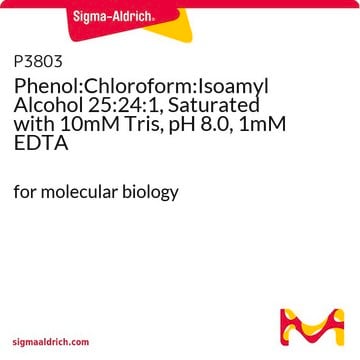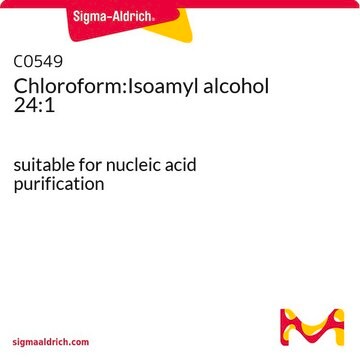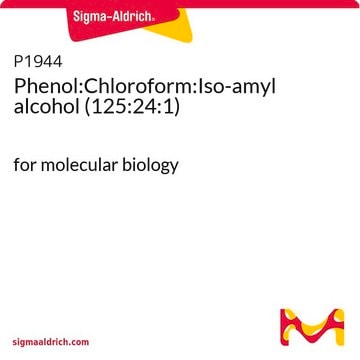P4682
Fenol solution
BioReagent, Saturated with 0.01 M citrate buffer, pH 4.3 ± 0.2, for molecular biology
Sinónimos:
nucleic acid extraction
About This Item
Productos recomendados
grade
for molecular biology
product line
BioReagent
form
liquid
technique(s)
RNA purification: suitable
pH
4.1-4.5 (25 °C)
storage temp.
2-8°C
SMILES string
Oc1ccccc1
InChI
1S/C6H6O/c7-6-4-2-1-3-5-6/h1-5,7H
InChI key
ISWSIDIOOBJBQZ-UHFFFAOYSA-N
Gene Information
human ... GABRA1(2554)
¿Está buscando productos similares? Visita Guía de comparación de productos
General description
Application
- for the extraction of RNA by standard phenol-chloroform protocols
- in cell wall monosaccharide analysis to treat epidermal strips from the abaxial side of Commelina communisin leaves
- as a component of lysis-denaturation buffer for RNA isolation
Biochem/physiol Actions
related product
signalword
Danger
Hazard Classifications
Acute Tox. 3 Dermal - Acute Tox. 3 Inhalation - Acute Tox. 3 Oral - Aquatic Chronic 2 - Eye Dam. 1 - Muta. 2 - Skin Corr. 1B - STOT RE 2
target_organs
Nervous system,Kidney,Liver,Skin
Storage Class
6.1A - Combustible acute toxic Cat. 1 and 2 / very toxic hazardous materials
wgk_germany
WGK 2
flash_point_f
Not applicable
flash_point_c
Not applicable
Certificados de análisis (COA)
Busque Certificados de análisis (COA) introduciendo el número de lote del producto. Los números de lote se encuentran en la etiqueta del producto después de las palabras «Lot» o «Batch»
¿Ya tiene este producto?
Encuentre la documentación para los productos que ha comprado recientemente en la Biblioteca de documentos.
Los clientes también vieron
Nuestro equipo de científicos tiene experiencia en todas las áreas de investigación: Ciencias de la vida, Ciencia de los materiales, Síntesis química, Cromatografía, Analítica y muchas otras.
Póngase en contacto con el Servicio técnico








